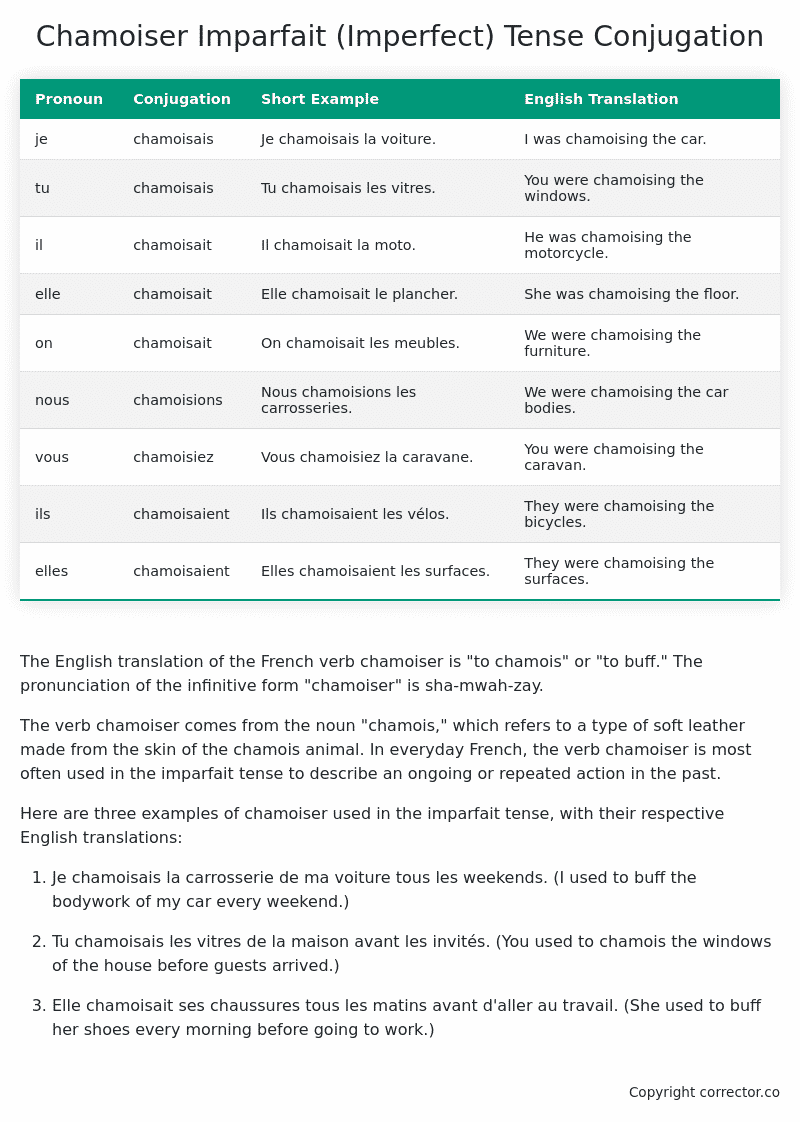Imparfait (Imperfect) Tense Conjugation of the French Verb chamoiser
Introduction to the verb chamoiser
The English translation of the French verb chamoiser is “to chamois” or “to buff.” The pronunciation of the infinitive form “chamoiser” is sha-mwah-zay.
The verb chamoiser comes from the noun “chamois,” which refers to a type of soft leather made from the skin of the chamois animal. In everyday French, the verb chamoiser is most often used in the imparfait tense to describe an ongoing or repeated action in the past.
Here are three examples of chamoiser used in the imparfait tense, with their respective English translations:
-
Je chamoisais la carrosserie de ma voiture tous les weekends.
(I used to buff the bodywork of my car every weekend.) -
Tu chamoisais les vitres de la maison avant les invités.
(You used to chamois the windows of the house before guests arrived.) -
Elle chamoisait ses chaussures tous les matins avant d’aller au travail.
(She used to buff her shoes every morning before going to work.)
Table of the Imparfait (Imperfect) Tense Conjugation of chamoiser
| Pronoun | Conjugation | Short Example | English Translation |
|---|---|---|---|
| je | chamoisais | Je chamoisais la voiture. | I was chamoising the car. |
| tu | chamoisais | Tu chamoisais les vitres. | You were chamoising the windows. |
| il | chamoisait | Il chamoisait la moto. | He was chamoising the motorcycle. |
| elle | chamoisait | Elle chamoisait le plancher. | She was chamoising the floor. |
| on | chamoisait | On chamoisait les meubles. | We were chamoising the furniture. |
| nous | chamoisions | Nous chamoisions les carrosseries. | We were chamoising the car bodies. |
| vous | chamoisiez | Vous chamoisiez la caravane. | You were chamoising the caravan. |
| ils | chamoisaient | Ils chamoisaient les vélos. | They were chamoising the bicycles. |
| elles | chamoisaient | Elles chamoisaient les surfaces. | They were chamoising the surfaces. |
Other Conjugations for Chamoiser.
Le Present (Present Tense) Conjugation of the French Verb chamoiser
Imparfait (Imperfect) Tense Conjugation of the French Verb chamoiser (You’re reading it right now!)
Passé Simple (Simple Past) Tense Conjugation of the French Verb chamoiser
Passé Composé (Present Perfect) Tense Conjugation of the French Verb chamoiser
Futur Simple (Simple Future) Tense Conjugation of the French Verb chamoiser
Futur Proche (Near Future) Tense Conjugation of the French Verb chamoiser
Plus-que-parfait (Pluperfect) Tense Conjugation of the French Verb chamoiser
Passé Antérieur (Past Anterior) Tense Conjugation of the French Verb chamoiser
Futur Antérieur (Future Anterior) Tense Conjugation of the French Verb chamoiser
Subjonctif Présent (Subjunctive Present) Tense Conjugation of the French Verb chamoiser
Subjonctif Passé (Subjunctive Past) Tense Conjugation of the French Verb chamoiser
Subjonctif Imparfait (Subjunctive Imperfect) Tense Conjugation of the French Verb chamoiser
Subjonctif Plus-que-parfait (Subjunctive Pluperfect) Tense Conjugation of the French Verb chamoiser
Conditionnel Présent (Conditional Present) Tense Conjugation of the French Verb chamoiser
Conditionnel Passé (Conditional Past) Tense Conjugation of the French Verb chamoiser
Conditionnel Passé II (Conditional Past II) Tense Conjugation of the French Verb chamoiser
L’impératif Présent (Imperative Present) Tense Conjugation of the French Verb chamoiser
L’impératif Passé (Imperative Past) Tense Conjugation of the French Verb chamoiser
L’infinitif Présent (Infinitive Present) Tense Conjugation of the French Verb chamoiser
L’infinitif Passé (Infinitive Past) Tense Conjugation of the French Verb chamoiser
Le Participe Présent (Present Participle) Tense Conjugation of the French Verb chamoiser
Le Participe Passé (Past Participle) Tense Conjugation of the French Verb chamoiser
Struggling with French verbs or the language in general? Why not use our free French Grammar Checker – no registration required!
Get a FREE Download Study Sheet of this Conjugation 🔥
Simply right click the image below, click “save image” and get your free reference for the chamoiser imparfait tense conjugation!

Chamoiser – About the French Imparfait Tense
NOTE: To take a deep dive into all the French tenses then see our article on Mastering French Tense Conjugation.
Formation of the Imparfait Tense
For regular -er verbs:
For regular -ir verbs
For regular -re verbs
Common Everyday Usage Patterns
Description of Past Habits
Background Information
Mental and Emotional States
It’s employed to express emotions, thoughts, or physical sensations in the past. For example: “J’étais content quand il est arrivé.” (I was happy when he arrived.)
Ongoing Actions
Points to Note About the Imparfait Tense
Passé Composé vs. Imparfait
Conditional
Si Clauses
Narration
I hope you enjoyed this article on the verb chamoiser. Still in a learning mood? Check out another TOTALLY random French verb imparfait conjugation!


